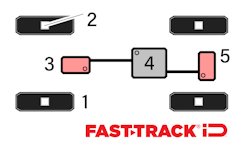Tire Pressure Monitoring System (TPMS)—The virtual tire kick
The tire pressure monitoring system (TPMS) of days gone by was to kick the tire to check for a hard, pressurized tire. Between that and a visual check, that was what we had, short of actually putting a tire gauge to work. Modern-day TPMS is a virtual tire kick that has developed into a highly accurate safety device.
The very first TPMS vehicle was a 1986 Porsche 959. The first in the U.S. was the 1997 Corvette. It was also the advent of the first Schrader TPMS tool.
In the early 2000s, there was a U.S. OEM that recalled vehicles due to rollover issues that happened because of tire failures. There were 279 deaths and 14.4 million tires involved. This triggered a law that mandated TPMS notify the driver when a tire is below 25% with a warning light in all vehicles under 10,000 lbs.
In the U.S., this law went into effect in 2008. A similar law was passed in the European Union and in the U.K. in 2012.
TPMS is designed to alert the driver to low tire pressure while the vehicle is traveling as well as when it is stationary. Low pressure is responsible for many accidents and breakdowns. The possibility is greatly increased when a tire has low pressure. Incorrect pressure also has a negative effect on fuel economy, emissions, and tire wear.
There are three methods for measuring tire pressure:
- A coded tire valve with a unique identifier is mounted within the load wheel.
- A coded tire valve with a transmitter mounted externally from the road wheel.
- An indirect system using output from the ABS wheel speed sensors.
The diagram below shows an example of method No. 1, the coded valve mounted within the wheel.
- Road wheel
- Tire valve
- Radio frequency receiver
- Body control module
- Instrument panel
The diagram below shows an example of method No. 2, the coded tire valve with an externally mounted transmitter.
- Road wheel
- Tire valve
- Transmitter antenna
- Tire pressure monitoring control module
- Spare wheel
- Instrument panel
Both methods use a radio frequency of 315 MHz or 433 MHz to relay pressure data to the control module. They also use a non-replaceable lithium-ion battery with a 7-year to 10-year life span.
The third method uses wheel speed sensors to calculate tire pressure. Low pressure results in a reduced tire circumference, which will alter the wheel speed sensor. Overinflation will increase the circumference, which will show up in the wheel speed as well.
Once the TPMS sensors are replaced, they may need to be calibrated to read the correct tire pressure based on the vehicle’s specifications, depending on the OEM. Some vehicles have specific needs such as towing or high load, which will need the tire pressure to be set higher.
Below is an example of a TPMS calibration on a Honda.
Snap-on diagnostic tools have a Quick Lookups feature, which when using current software includes today's OEM-specific tire and wheel service information, such as remove and repair instructions, functional reset procedures through the scan tool, and manual reset procedures after a sensor is replaced.
Note that certain OEMs may need the Snap-on TPMS4 or TPMS5 for TPMS relearns, but for diagnosing the tire pressure monitoring system, Snap-on scanners offer codes, current codes, and history codes, along with clear codes. All this TPMS information, data, and more is now also available in Spanish on a SOLUS+ with current software.
Trouble codes may indicate issues such as:
- Tire pressure too low or too high
- Defective tire pressure sensors
- Faulty TPMS control unit
- Faulty wiring
- TPMS reset needed
Furthermore, tire pressure monitoring systems have data displays available on many scan tools. It offers various data, depending on the OEM, such as air pressure, obviously, and maybe even tire temperatures. Some list the registration ID. Vehicle speed and sensor battery voltage might be included, too. In fact, some may show battery remaining service life in months.
Additionally, functional tests or special functions like tire pressure adaption, manual procedures, and right tire position are available for OEMs.
Tire pressure monitoring systems are definitely more accurate and safer than kicking the tires, plus they will monitor the tires at 70 mph. A tire kick at that speed might be a bit of a challenge.
Click here for more on this topic.






